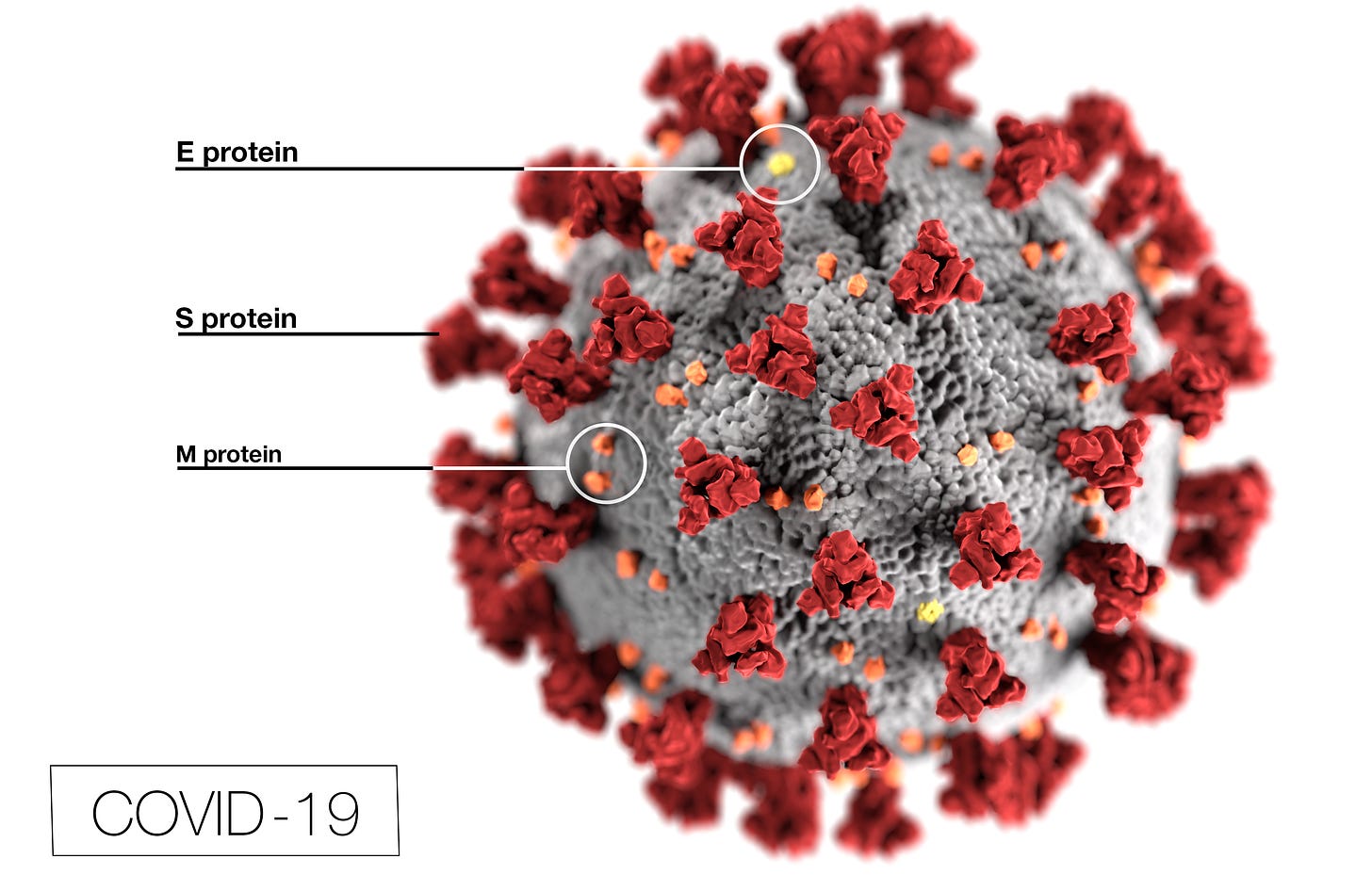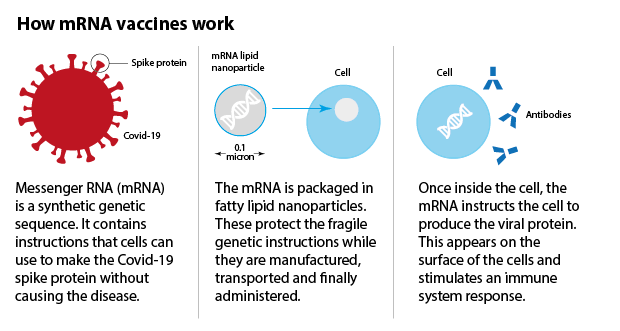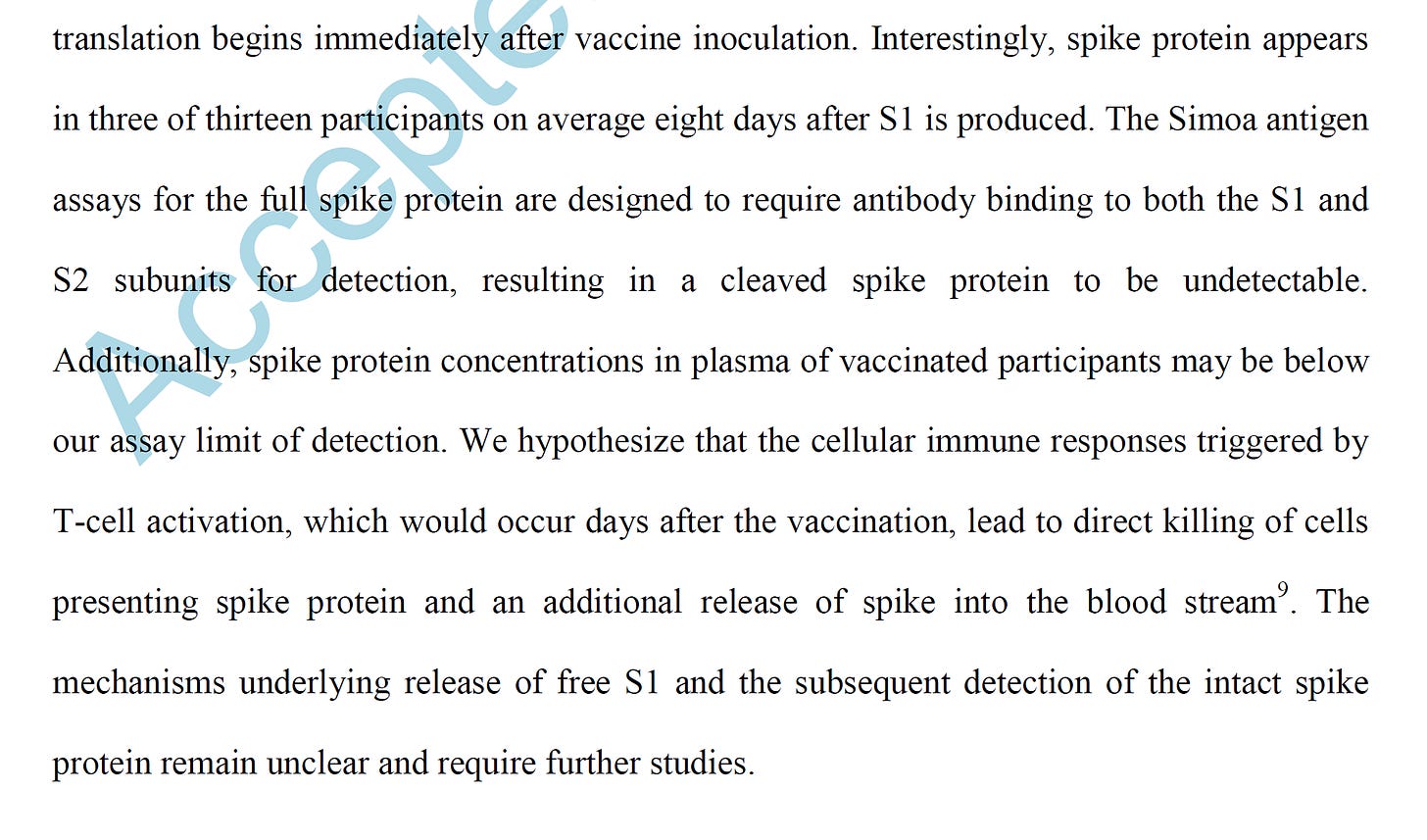there has been a lot of concern and loose talk about mRNA vaccines from both sides of the debate. my goal here is not to address all of it or to tell you what to do (ask a trusted healthcare expert) but rather to look at one specific issue that seems to be coming up a lot lately: the spike proteins coded for by mRNA vaccines. there has been a lot of worried talk about how “the vaccines are coding for spike proteins and making people sick” in particular in response to this STUDY showing that 11 of 13 had detectable vaccine-encoded spike protein after inoculation.
taken alone, this can be portrayed as worrying as it’s the spike proteins of covid-19 that make it so unusually potent and turn it from a respiratory disease into a vascular one. these are the proteins that bind to the epithelial cells in vascular tissue. you can read more on this HERE.
this certainly poses a danger from SARS-cov19.
the question is: does it pose a danger from vaccines?
to start, let’s recall that all vaccines are dangerous. this is inevitable. it’s also kind of meaningless. so is all exercise. the question is “how does that danger compare to the benefit?” that’s always the essence of medical treatment.
people used to willingly (and rationally) use variolation inoculation where needles dipped in pus from live measles infections would be used to introduce it into their systems. this had something like a 1% fatality rate. to modern minds, that sounds horrifying. but compared to the risk of living near a measles outbreak? it was an attractive option. having danger did not make bad.
all vaccines work by teaching your immune system to recognize and respond effectively to a pathogen. think of it as training. you learn that “something that looks like X is dangerous, attack it and kill it, here’s how” and you file it away. in essence, you’re looking for the safest possible exposure to teach a lesson sufficient to have it stick. that’s the art of vaccines.
mRNA vaccines function differently from the traditional variolation vaccines that evolved into vaccines using inert or non-functioning versions/fragments of viruses to increase safety.
an mRNA vaccine is not all or part of a pathogen, it’s a set of instructions delivered to your cells that cause them to code for specific proteins. those proteins are designed to look sufficiently like the proteins of a specific pathogen to trigger immune response and immune memory.
so, the idea that “finding this spike protein in plasma” is some sort of serious issue seems odd as a criticism. it’s supposed to be there.
the whole mechanism of action of an mRNA vaccine is to code for it, get your cells to produce it, and then get your immune system to respond to it and learn to fight live covid-19. as cells with this protein on the outside die, the protein winds up in plasma.
so let’s look at what this ogata study (linked above) that is causing such consternation is really telling us:
the spike protein coded for by mRNA-1273 (moderna vaccine) is called S1 and is distinct from the spike proteins of “wild” COV19.
it has a transmembrane anchor and a cleavage at S1/S2 that renders the protein both incomplete and separately identifiable from wild versions.
theoretically, these differences render it less dangerous than wild covid
these differences also allow assays to discern S1 from “spike” which is the complete protein
nucleocapsids were tested for as well to provide a negative control. response to live covid virus would have triggered them, response to a vaccine would not.
so, what we see is that the results were from vaccine, not infection, we got a short term spike in S1 that was largely gone by day 9 and all but entirely so by day 30. the drop in S1 looks to be tightly correlated temporally with the rise in IgG response (both to S-1 and spike)
that’s precisely what you’d expect if this vaccine were working. you code for S1 proteins, make them, trigger immune response, and clear them. the immune response triggers antibody production (IgG) for both S1 and vs wild S protein (called “spike” in the chart)
this is the outcome you want and likely explains the HIGH EFFICACY of vaccines.
some have expressed concern about the 3 patients exhibiting actual spike protein. the authors posit that this is just cell necrosis releasing small amounts of live virus from cells where it had existed in trace amounts.
this strikes me as both plausible given the endemic nature of the virus and perhaps positive as it implies that patients immune systems went right after wild virus too as they manifested their IgG response.
keep in mind that the simoa assay they are using is incredibly sensitive and that we’re talking about truly tiny concentration levels here of <150 pg/ml. unless i’m mis-calibrated here you’d generally see numbers in the 1,000’s or 10’s of thousands for high viral loads. (and if i am, would love some guidance/context on that)
so does this mean the vaccines are safe?
no. but it does not mean they are worryingly dangerous either.
this study outlines no new dangers that i can see and seems to validate method of action and the general principle of mRNA vaccines thus bolstering efficacy, but safety is a more complex issue. it was not addressed in this study.
clearly, these vaccines are triggering an immune response. widespread data and lots of folks to whom i have spoken seem to validate that yes, people often feel crappy for 12-36 hours after either the first or second dose. that’s immune response for you. it happens with lots of childhood vaccines too.
but perhaps the bigger question is: so is this truncated and anchored S1 protein dangerous in its own right and if so, to what extent?
just how “nerfed” is S1 vs the wild S protein? can and to what extent can it infect vascular epithelial cells and cause disease, blood clots, strokes, and other complications?
i’m not really deep enough into that data to have a strong view. people are arguing about VAERS reporting and miscounting and various and sundry other issues and bucking internet tradition, about that which i know little, i am going to stay quiet apart from saying it bears investigation and that as there has never been an mRNA vaccine approved in humans (including these which are just on EUA, not approval) we’re a bit off the edge of the map here. this is new stuff and we’re still learning.
that said, S1 expression seems to recede rapidly and drop to uncommon instances of very low concentration after about 8 days, so it would seem that the burden of proof that these effects will be anything other than transitory would lie with those claiming such effects to exist.
so, i hope that helps. real debate and discussion here is needed and useful.
just trying to add a bit to and and clarify what i can.
feel free to pass on other takes and more information. this is intended to be collaborative and constructive. i’m still learning on this issue too.











I think the concern following the results in the Harvard/Brigham paper is that they have shown that there is S1 in the plasma, i.e. not confined simply to expression on the surface of cells. When people have expressed concern about the vaccines in terms of "is spike by itself dangerous", the expert answer has been "the spike only appears partially extruded on a cell surface", i.e. it can't get to the lungs, the vascular epithelium, etc. The paper shows that is not correct, which in turn suggests we don't completely know all the downstream consequences.
The larger theoretical concern, in my view, with the mRNA vaccines is that the set of cells that can be "transfected" by the lipid nanoparticles (LPNs) is essentially all cells, in distinction to the SARS2 virus, which can only infect cells with ACE2 receptors. In other words, any cell that the LPNs reach can end up expressing spike on its surface, and thereby invite immune attack. So it matters very much that the belief is that this will be mainly local muscle, and next most-likely local lymph nodes. But we also know that with decreasing probability (per animal study) the LPNs reach essentially every organ including the brain and the bone marrow. The other thing I find interesting is that the kinds of adverse events that are beginning to emerge as related (I have more ideas about how to do that analysis better) are of the type and range you might expect if caused by comparatively uncommon but diverse instances of mRNA getting around: eg myocarditis (heart cells), thrombosis (vascular epithelium, platelets, perhaps bone marrow), various forms of neuritis (ocular, vestibular, peripheral) via nerve cells, and so on. To get a handle on the range of adverse effects you need to collate all of these, since they each present as a unique type of relatively rare event. But they do have in common the potential mechanism of targeted inflammation and/or cell damage that would be caused by spike expression in a particular cell type.
All of this jives with my casual exploration of the data. The vaccine seems quite safe for most in the short term. For those with significant risk factors for poor Covid outcomes, the vaccine seems a very reasonable option. The question of both long-term efficacy and long-term negative effects is still in question, particularly for those cohorts excluded from the initial trials, i.e. the young, pregnant women, those who have had Covid, etc.
It is truly remarkable that we were able to develop this vaccine so quickly and that it appears to have such a high level of efficacy. It is however unconscionable that governments, public health officials, businesses and schools would advise those with low risks or (and more disturbingly) compel *anyone,* regardless of their risk profile, to accept what is still a very new bit of technology.